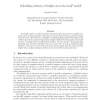Free Online Productivity Tools
i2Speak
i2Symbol
i2OCR
iTex2Img
iWeb2Print
iWeb2Shot
i2Type
iPdf2Split
iPdf2Merge
i2Bopomofo
i2Arabic
i2Style
i2Image
i2PDF
iLatex2Rtf
Sci2ools
PC
2000
2000
Scheduling outtrees of height one in the LogP model
The LogP model is a model of parallel computation that characterises a parallel computer system by four parameters: the latency L, the overhead o, the gap g and the number of processors P. We study the complexity of scheduling fork graphs in the LogP model. It will be proved that constructing minimum-length schedules for fork graphs in the LogP model is a strongly NP-hard optimisation problem. We also present a polynomial-time algorithm that constructs schedules that are at most twice as long as minimum-length schedules. Moreover, we prove that if all tasks of a fork graph have the same execution length, then a minimum-length schedule can be constructed in polynomial time.
| Added | 19 Dec 2010 |
| Updated | 19 Dec 2010 |
| Type | Journal |
| Year | 2000 |
| Where | PC |
| Authors | Jacques Verriet |
Comments (0)

